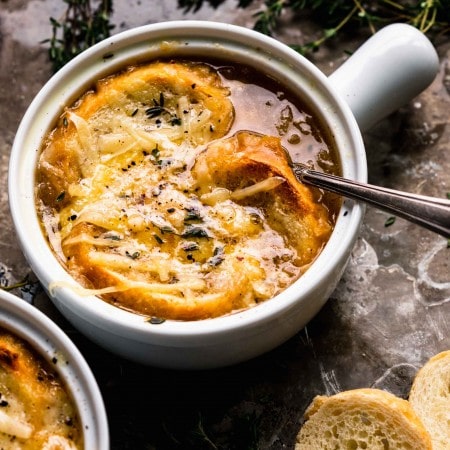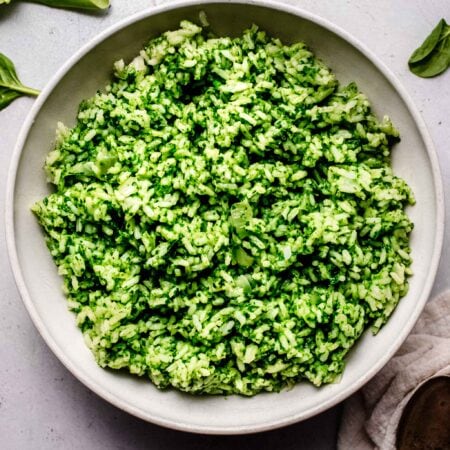This easy Bearnaise sauce recipe is rich, fluffy, and tangy. This sauce can be used on a variety of dishes, like steak, seafood and asparagus.

Want to Save This Recipe?
Enter your email & I'll send it to your inbox. Plus, get great new recipes from me every week!
By submitting this form, you consent to receive emails from Platings + Pairings.
Interested in more savory sauce recipes? Try out my Steak Diane, Steak with Red Wine Sauce, Bordelaise Sauce, Lemon Butter Sauce and Homemade BBQ Sauce.
Bearnaise sauce (also spelled Béarnaise sauce) is an extremely versatile classic sauce. It is generally associated with steak or Filet Mignon, but it’s also a delicious sauce for asparagus. Its name is related to the province of Béarn, France.

Bearnaise is a loose derivative of hollandaise sauce. Hollandaise is an egg yolk mixture emulsified with unsalted butter and acid. Hollandaise sauce is also one of the five mother sauces of French cuisine, meaning it can be used to make a range of other sauces.
Bearnaise builds on hollandaise with egg yolks, butter, white wine vinegar, shallots, and tarragon. The mildness of these flavorings make it perfect for chicken and beef as well as seafood. This luscious sauce is especially popular for grilled or broiled meats, such as Broiled Lamb Chops. It’s also incredibly delicious with french fries!
With this easy recipe, you’ll be able to master this delicious sauce the first time.
What is in Bearnaise sauce?
- Shallot
- White Wine Vinegar – Gives this sauce its tangy flavor.
- Fresh Tarragon – Tarragon has an amazing flavor that’s slightly like black licorice. Can’t find fresh tarragon? Try one of these tarragon substitutes.
- Egg Yolks – This is what gives the sauce its creamy, fluffy texture.
- Unsalted Butter – Using unsalted butter guarantees that you can control the salt level of your finished sauce.
- Lemon Juice – Fresh squeezed is best here!
- Salt + Pepper

How to make it
- In a small skillet, add the shallots, vinegar, pepper and 1 tablespoon of tarragon leaves and bring to a boil over medium heat.
- Reduce heat to a simmer over low heat and cook until almost all of the liquid has evaporated. Remove from heat and place in a metal mixing bowl. Allow to cool.
- Meanwhile, fill a small saucepan with an inch or two of water. Bring to a boil over medium-high heat. To the cooled shallot reduction, add the egg yolks and a dash of cold water. Whisk to combine.
- Place the metal bowl over the saucepan of simmering water and turn the heat down to low. Keep an eye to be sure the bowl isn’t touching the boiling water.
- Whisk the egg-shallot mixture until it begins to thicken, about 5-6 minutes.
- Melt butter in the microwave or on the stove, then gradually whisk it in, a splash at a time. Continue whisking until the sauce has emulsified and coats the back of a spoon.
- Remove from the heat and stir in the lemon juice and remaining 1 tsp. chopped tarragon leaves.
- Season with salt, to taste. Enjoy!

Recipe tips
- Unfortunately, this sauce cannot be reheated. However, it can be held at temperature in a sous vide water bath at 130 degrees for up to 4 hours. Add the sauce to a mason jar and place it in the bath.
- If the sauce gets too hot while whisking, you’ll end up with scrambled eggs.
FAQs
Béarnaise sauce has a rich, creamy, and tangy flavor with a slight herbal, licorice-like note from the tarragon. The sauce is known for its velvety texture and buttery taste, and it pairs well with a variety of dishes, including steak, fish, and vegetables. Overall, Béarnaise sauce is a flavorful and indulgent addition to any meal.
Béarnaise sauce and hollandaise sauce are both classic French sauces made with butter, egg yolks, and acid (typically vinegar or lemon juice), but they differ in a few key ways. The main difference between the two sauces is the addition of tarragon and shallots in béarnaise sauce, which gives it a distinct flavor and aroma. Béarnaise sauce also typically includes white wine in its ingredient list, while hollandaise sauce does not.
In terms of texture, béarnaise sauce is often thicker and more velvety than hollandaise sauce, due to the reduction of the shallots and the addition of tarragon. Hollandaise sauce, on the other hand, is known for its smooth, silky texture.
Yes. Overall, while both sauces are similar in composition and are often used interchangeably. However, it’s the addition of tarragon and shallots in béarnaise sauce that gives it a unique flavor profile and texture.

What does Bearnaise sauce go with?
- Sous Vide Filet Mignon
- Air Fryer Filet Mignon
- Sheet Pan Salmon
- Traeger Steak
- Easy Roasted Chicken
- Broiled Lamb Chops
- Deviled Eggs or Eggs Benedict
- Roasted Vegetables
What to serve on the side
- Instant Pot Baked Potatoes
- Sour Cream Mashed Potatoes
- Roasted Brussels Sprouts with Balsamic Glaze
- Glazed Carrots
- Roasted Miso Cauliflower
- Easy Arugula Salad
- MORE → 50+ of the best sides for steak
Wine pairings for steak with Bearnaise sauce
- Full-bodied Chardonnay
- Viognier

More homemade sauce recipes
- Romesco Sauce
- Mustard Sauce for Steak
- Creamy Peppercorn Sauce
- Beef Gravy
- Red Wine Jus
- Creamy Mushroom Sauce
- Bordelaise Sauce
- Red Wine Sauce
- Lebanese Garlic Sauce
- Mojo Sauce
- Chimichurri Sauce
- MORE → my must try steak sauce recipes
Did you try this Bearnaise sauce recipe?
If you loved this bernaise sauce I would appreciate it so much if you would give this recipe a star review! Also, be sure to snap a picture of your finished dish and share it with me on Instagram using the hashtag #platingsandpairings and tagging me @platingsandpairings.
For more great Platings and Pairings recipes, be sure to follow me on Instagram, TikTok, Pinterest and Facebook.

Easy Bearnaise Sauce
Ingredients
- 2 tbsp minced shallot (1 small shallot)
- ¼ cup white wine vinegar
- ½ tsp fresh cracked black pepper
- 1 tbsp chopped tarragon leaves (plus 1 teaspoon)
- 2 egg yolks
- 12 tbsp unsalted butter, melted
- 1 tsp lemon juice
- Kosher salt (to taste)
Instructions
- In a small skillet, add the shallots, vinegar, pepper and 1 TBSP tarragon leaves and bring to a boil over medium heat. Reduce heat to a simmer and cook until almost all of the liquid has evaporated. Remove from heat and place in a metal mixing bowl. Allow to cool.
- Meanwhile, fill a small saucepan with an inch or two of water. Bring to a boil over medium-high heat.
- To the cooled shallot mixture, add the egg yolks and 1 TBSP water. Whisk to combine.
- Place the metal bowl over the saucepan of boiling water and turn the heat down to low. Keep an eye to be sure the bowl isn’t touching the boiling water.
- Whisk the egg-shallot mixture until it begins to thicken, about 5-6 minutes.
- Gradually whisk in the butter, a splash at a time. Continue whisking until the sauce has emulsified.
- Remove from the heat and add the lemon juice and remaining 1 tsp. tarragon leaves. Season with salt, to taste. Serve.
Notes
Nutrition
This post was originally published in 2021. It was updated in 2023 to add new content. The bearnaise sauce recipe remains the same. Enjoy!








I found it tasty, but had trouble on the emulsification. My food processor saved the day though, made it very creamy texture.